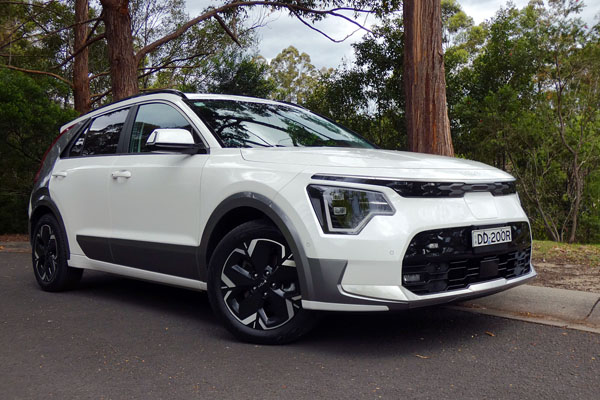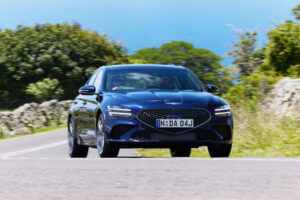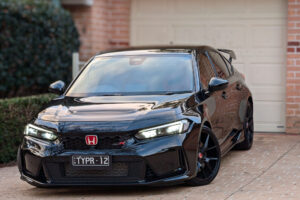
Kia Niro is a compact, five-seat crossover offered by Kia since 2016. Second generation
Niro was launched in late 2021 and is essentially a downsized vessel for Kia’s electric
technology.
A partner for the larger, higher-priced EV6, it’s offered in three versions overseas: hybrid,
plug-in hybrid and battery electric variants.
Australia takes the hybrid and fully electric versions and the one we’re looking at here is
the fully electric top spec Niro EV GT-Line.
We were pretty impressed with the previous version and eager to see what changes had
been made with the replacement which lobbed in July this year. The basics remain the
same, but there’s a lot more bling and of course the price has gone up to match.
STYLING
All-new Niro features the latest version of Kia’s signature Tiger Face, which extends from
the bonnet to the bumper below.
Although the shape of the wagon is conventional, the look has been enhanced by striking
‘heartbeat’ daytime running lights (DRLs), a bold skid plate and coloured side cladding
which combine to lift the look.
The side profile features a striking C-Pillar, finished in contrasting colours, which
incorporates an air channel that exits behind the tail lights to help to improve aerodynamic
efficiency.
At the rear, Volvo-like tail lights complete the look, while the heartbeat-shaped rear
reflector, skid plate and lower bumper complement the front design.

Niro EV comes in two grades: S and GT-Line. S is priced from $65,300 and the GT-Line
from $72,100 plus on-roads. Premium adds $520.
Our car was finished in Snow White Pearl with a Steel Grey C pillar. Inside, recycled
materials have been used to reduce the environmental footprint.
The headlining is made from recycled PET materials, the seats are made from Bio PU with
Tencel from eucalyptus tree fibres and BTX-free paint (without benzene, toluene, and
xylene) is used on the door panels.
Options for personalisation include a choice of contrasting C-Pillar colours with the GT-
Line: Cityscape Green or Mineral Blue can be combined with a gloss black C-Pillar, while
Snow White Pearl can be paired with a C-Pillar and cladding in Steel Grey.
Standard kit includes two-zone climate air, cloth/artificial leather trim, power-adjust front
seats and a heated steering wheel.
There’s also heads-up display, smart cruise control with stop and go, remote smart parking
assist, auto high beam, auto lights and wipers, auto-dimming rear vision mirror, a hands-
free tailgate, wireless Qi charger and telematics (eCall, Remote Control, Vehicle Status
Monitoring etc).
EV GT-Line adds ambient lighting, LED headlights, ventilated front seats, tilt and slide
sunroof, front passenger reclining relaxation seat and V2L which means you can use the
car to power other devices.
INFOTAINMENT
Infotainment in the GT-Line consists of a 12.3-inch touchscreen and eight speaker Harman
Kardon audio, with voice control, built-in navigation, with AM/FM and DAB digital radio and
the Sounds of Nature background noise.
Once again, the cheaper S gets wireless Apple CarPlay and Android Auto while the GT-
Line makes do with the wired version of both. Go figure?

ENGINES / TRANSMISSIONS
As well as a platform, Niro shares its powertrain and battery pack with the Hyundai Kona
Electric.
This means 150kW of power and 255Nm of torque, Single Speed Transmission (reduction
gear) that drives the front wheels and a battery capacity of 64.8kWh.
SAFETY
Safety features include eight airbags, rear view camera with dynamic guidelines and
autonomous emergency braking (AEB), with Car, Pedestrian, Cyclist and Junction Turning
detection.
There’s also Multi Collision Braking (MCB), Blind Spot Collision Avoidance Assist (BCA),
Rear Cross Traffic Collision Avoidance Assist (RCCA) and Intelligent Speed Limit Assist
(ISLA) as standard across all trim levels.
Other standard safety features include Lane Keeping Assist (LKA), Driver Attention
Warning (DAW), High Beam Assist (HBA), Lane Following Assist (LFA), Rear View
Monitor (RVM) and Rear Cross-Traffic Collision-Avoidance Assist (RCCA).
GT-Line adds Front and Rear Parking Sensors, Parking Collision-Avoidance Assist
Reverse (PCA-R), Safe Exit Assist, Power Child Lock and Emergency Service ‘eCall’
through the Kia Connect functions.
DRIVING
There are four selectable drive modes: Eco, Normal, Sport and Snow (the latter replacing
Eco+). Each has a different effect on things like the air-con and electric motor torque
profile.
A ‘virtual’ engine sound compensates for lack of engine noise. Supposedly, if you don’t like
it, you can turn it off (we couldn’t find how to do so).
The dash from 0-100 km/h takes 7.8 seconds, it has a top speed of 167km/h and a very
useable driving range of 460 km (WLTP) — 5km more than the model it replaces.
The 423kg battery array is secreted under the floor and takes the weight of the car to a
hefty 1727 kg.
It’s a much snazzier looking thing than the previous model, with cool LED lights, an
interesting rear pillar design and two-tone paint work that all make it stand out.
A new car has not been launched that hasn’t grown in dimensions and Niro is no
exception.
The EV’s dimensions have grown 45mm in length to 4420mm, 20mm in width to 1825mm,
with a height the same at 1570mm EV. The wheelbase has also grown 20mm longer to
2720mm.
Unlike the hybrid, the EV is fitted with smaller, aerodynamic, 17-inch alloys and 215/55
R17 Michelin Primacy 3 rubber.
Boot space has grown to 475 litres behind the rear seats, with a tyre repair kit for
punctures.
The dated interior of the previous model has been replaced by hi-tech, minimalist decor
echoing rivals such as the Volvo and Polestar.
Colourwise, it’s a combination of bone, grey and piano black trim, with some metal-look
finishers. Some of the grey is textured, but there needs to be more colour variation.
A pair of 10.25-inch digital screens, one for the instruments and a touch sensitive one for
infotainment merge to create a single sweeping effect.
Touch sensitive aircon controls sit below the centre screen, separated from the screen
above by a pair of slim line air vents.
Kia says the layout removes clutter for a clean and coherent look and ensures front seat
occupants can access these important controls without the need to scroll through multiple
menus.
That may be so but try turning down the volume if you’re the front seat passenger. There’s
no physical volume knob and nothing apparent in the infotainment system.
Same goes for finding your favourite radio station. It assumes the operator knows to swipe
the screen left to expose more options including the radio.
There’s no physical home button either.
For once in a very long time, I found this latest Kia system difficult to use. Bad move guys.
Like the previous model, the drive experience is fun, punchy when necessary, with decent
range to keep any feelings of anxiety at bay.
With 420 kilos of battery riding close to the road, Niro is surprisingly well anchored in
corners, although weight eventually tells against it as it tries to run wide.
The ride can be harsh and bouncy at times (EVs don’t like speed humps).
Performance is rapid but not what we’d describe as flat out quick. Punch the accelerator
and it surges forward, putting annoying tailgaters in their place — but they’re not gone and
forgotten.
We clocked up more than 500km at an average of 14.7 kWh/100km.
Niro EV seems reluctant to give up its stored energy, with distance to empty changing
hardly at all sometimes — unlike some EVs that chew through their charge quickly.
Charging is via Type 2 AC or CCS Combo 2 DC connections and we’re happy to say the
charge port is conveniently located at the front of the car.
Given a choice, I’d prefer all my EVs to come this way, as it makes nosing the car into the
charger much easier. Note though that not all chargers you come across support all types
of connection, and you may require an adaptor.
Satnav by the way keeps track of the nearest charge station.
Topping up the EV’s 64.8kWh lithium-ion polymer battery from 10-100 per cent using the
supplied cable and standard powerpoint will take 27 hours 30 mins.
With a standard 7kW wall box this reduces to 9 hours 25 mins, or with a more powerful
11kW box, 6 hours 20 mins. A fast DC charger can do it in as little as 43 minutes.
Energy from braking is reclaimed and fed back into the battery. It can be controlled using
steering wheel paddles and permits one-pedal driving.
Lift your foot off the accelerator and the car will brake automatically.
While it all sounds like fun, the purchase of an electric car is a big commitment.
Like I’ve said in the past, buying an EV, at least at this stage of the game, is something of
a lifestyle choice. Be warned because it could take over your life.
SUMMING UP
The previous model offered value for money in terms of an EV.
Price creep has made this one less attractive, together with a nerdy control system.
You’ve got to keep someone sensible in charge, preferably a woman. I hate myself for
saying this — but they are better at cutting through the hype.
RATINGS:
Looks: 7.5/10
Performance: 7.5/10
Safety: 8/10
Thirst: 7.5/10
Practicality: 7.5/10
Comfort: 7/10
Tech: 8/10
Value: 6/10
Overall: 7.4/10
AT A GLANCE
MODEL RANGE
Niro S HEV: $44,380
Niro GT-Line HEV: $50,030
Niro S EV: $65,300
Niro GT-Line EV: $72,100
Note: These prices do not include government or dealer delivery charges. Contact your
local Kia dealer for drive-away prices.
SPECIFICATIONS (Kia Niro EV, battery/electric, front-wheel drive, five-door wagon)
PERFORMANCE:
Battery capacity: 64.8 kWh
Maximum Power: 150 kW
Maximum Torque: 255 Nm
Fuel Type: Electricity
Plug Type: Type 2/CCS Combo2
Charging: Up to 11kW (AC) or 350kW (DC)
Maximum range: 460 km
Energy Use: 16.2 kWh/100km
CO2 Emissions: 0 g/km
DRIVELINE:
Single Speed Transmission (Reduction Gear), front-wheel drive
DIMENSIONS, WEIGHT AND CAPACITIES:
Length: 4420 mm
Wheelbase: 2720 mm
Width: 1825 mm
Height: 1570 mm
Turning Circle: 10.6 metres
Kerb Mass: 1727kg
BRAKES:
Front: 305 mm Ventilated Disc
Rear: 284 mm Sold Disc
STANDARD WARRANTY:
7 years/Unlimited kilometre warranty. Battery and electric motor are covered by a 7
years/150,000km warranty.








